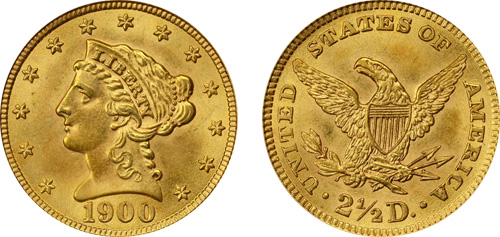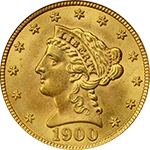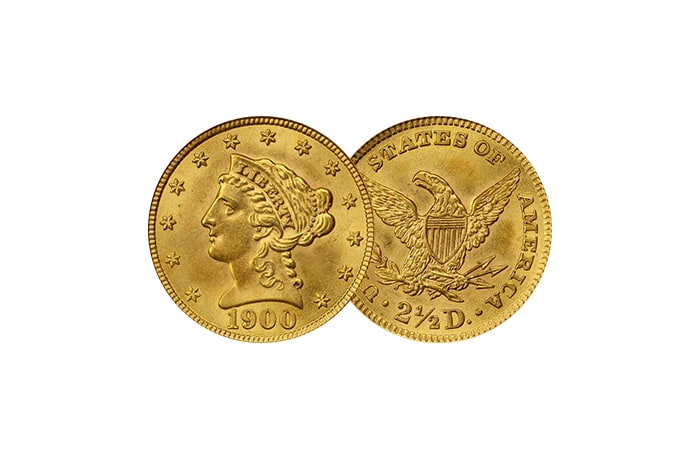The U.S. Mint pressed the $2.50 Liberty Head gold coin between 1840 and 1907. A $2.50 gold coin is also referred to as a quarter eagle, as a $10 gold coin is termed an eagle. This particular design is sometimes also called “Coronet,” for the decoration in Liberty’s hair. By the 1830s, officials hoped to create a design that would serve as an enduring symbol of American gold coinage. Indeed, the Liberty Head circulated for nearly 70 years, achieving unsurpassed longevity in U.S. history. To put this into perspective, the coin was in circulation from the era of westward expansion to the dawn of World War.
The Mint started commissioning designs for the country’s new gold coinage in 1834. After several designs had been submitted, Christian Gobrecht’s Coronet was finally accepted in 1838. Gobrecht was an American engraver, sculptor, and an inventor. He took over as the third U.S. Mint Chief Engraver in 1840, but had previously held other positions in the Mint. Gobrecht is also famous for the Seated Liberty design of the silver coins and the Braided Hair Liberty Head design that of the large cents and half cents.

While the obverse image of Liberty’s profile changed in the 20th Century, the original essentially remained the same. The obverse side shows Liberty in profile facing left while her hair is pulled back into a bun that is held in place with a tie of stringed pearls. She also wears a coronet with the inscription “LIBERTY.” Thirteen stars, representing the original colonies, circle almost the entire of the coin while the mint date is located at the bottom. The reverse side features the heraldic eagle, similar to the one that had been pressed into quarter eagles over the previous 30 years. However, Gobrecht modified the design a bit: the eagle is standing and clutching arrows and an olive branch, representing a country that prefers peace but is prepared to go to war. The eagle’s wings are spread and a union shield is covering its chest. The legend “THE UNITED STATES OF AMERICA” surrounds the eagle around the top. The denomination “2 1/2 D” is found at the bottom.
The U.S. Mint produced almost 12 million of Liberty Head quarter eagle coins from 1840 to 1907. They were struck in Philadelphia, Charlotte, Dahlonega, and New Orleans. As usual, coins minted in Philadelphia bear no mark. The marks for Charlotte, Dahlonega, and New Orleans are C, D, and O, respectively. Note that D usually stands for Denver, but this gold coin is an exception. The mark can be found below the heraldic eagle if it is there.
The $2.50 Liberty Head gold eagle consists 1 of 90% gold and 10% copper.
The Mint also produced a little over 4,000 proof coins. The early ones are extremely rare; only two or three pieces are believed to have survived. Proofs frequently have frosted white devices contrasting with deeply mirrored fields. Most of the proofs minted after 1902 have an all-brilliant finish and feature no contrast between devices and field. Since the Liberty Head quarter eagle was in circulation for 68 years, it is exceptionally difficult for collectors to complete the series. Coins minted in Charlotte and Dahlonega are especially rare and expensive in mint condition. San Francisco and New Orleans issues are also scarce in AU and mint state. Liberty Head quarter eagles struck in Philadelphia are the most commonly found mint state coins, although issues from the Civil War years are still very rare.
The most historically significant issue though is the 1848 CAL quarter eagle, which was minted from some 230 ounces of native California ore in 1848. These 1,389 coins bear the abbreviation “CAL” above the eagle’s head on the reverse side. Authentic specimens feature a square period after the “CAL” inscription. Two other coveted Philadelphia issues are the 1841 (also called “The Little Princess”) and the 1875 Liberty Head quarter eagle, both of which are quite elusive. The first issue struck in San Francisco, the 1854-S, is also extraordinarily rare as only about 10 coins are thought to exist today.
The Liberty Head $2.50 gold coins are very attractive to those interested in numismatics as well as to those seeking to invest in gold. As the numismatic value of these quarter eagles may exceed the gold bullion value, interested parties are advised to contact experienced precious metals consultants before buying or selling Liberty Head gold coins.


